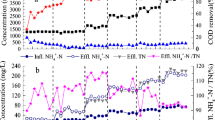Abstract
An alternating pumped sequencing batch biofilm reactor (APSBBR) system was developed to treat small-scale domestic wastewater. This laboratory system had two reactor tanks, Reactor 1 and Reactor 2, with two identical plastic biofilm modules in each reactor. Reactor 1 of the APSBBR had five operational phases—fill, anoxic, aerobic, settle and draw. In the aerobic phase, the wastewater was circulated between the two reactor tanks with centrifugal pumps and aeration was mainly achieved through oxygen absorption by microorganisms in the biofilms when they were exposed to the air. This paper details the performance of the APSBBR system in treating synthetic domestic wastewater over 18 months. The effluent from the APSBBR system satisfied the European Wastewater Treatment Directive requirements, with respect to COD, ammonium-nitrogen and suspended solids. The biofilm growth in the two reactor tanks was different due to the difference in substrate loadings and growth conditions.




Similar content being viewed by others
References
Smith D, O’Neill N, Doris Y, Moriarty J (2004) Urban waste water discharges in Ireland with population equivalent greater than 500 persons: a report for the years 2002 and 2003. Irish EPA, Ireland
Boller M (1997) Small wastewater treatment plants—a challenge to wastewater engineers. Water Sci Technol 35:1–12
Odegaard H, Rusten B (1980) Nitrogen removal in rotating biological contactors without the use of external carbonaceous source. In: Proceedings of the first national symposium/workshop on rotating biological contactor technology, vol. 1. Champion, Pennsylvania, pp 1301–1317
APHA (1995) Standard methods for the examination of water and wastewater, 19th edn. American Public Health Association, Washington
Tanyolaç A, Beyenal H (1996) Effectiveness factor for a hollow-fiber biofilm reactor at maximum substrate consumption. Chem Eng J 62:149–154
Wäsche S, Horn H, Hempel DC (2002) Influence of growth conditions on biofilm development and mass transfer at the bulk/biofilm interface. Water Res 36:4775–4784
Schramm A, Larsen LH, Revsbech NP, Ramsing NB, Amann R, Schleifer K-H (1996) Structure and function of a nitrifying biofilm as determined by in situ hybridization and the use of microelectrodes. Appl Environ Microbiol 62:4641–4647
Nishidome K, Kusuda T, Watanabe Y, Yamauchi M, Mihara M (1994) Determination of oxygen transfer rate to a rotating biological contactor by microelectrode measurement. Water Sci Technol 29(10–11):471–477
Tipadis G (1991) Mathematical model for wastewater treatment by the rotating biological contactor process. PhD Thesis, Imperial College, University of London
Acknowledgements
The authors are very grateful to Enterprise Ireland for financial support and to RPS-MCOS Ltd. for the M.C. O’Sullivan Postgraduate Scholarship awarded to Edmond O’Reilly in 2002.
Author information
Authors and Affiliations
Corresponding author
Rights and permissions
About this article
Cite this article
Rodgers, M., Zhan, X. & O’Reilly, E. Small-scale domestic wastewater treatment using an alternating pumped sequencing batch biofilm reactor system. Bioprocess Biosyst Eng 28, 323–330 (2006). https://doi.org/10.1007/s00449-005-0038-8
Received:
Accepted:
Published:
Issue Date:
DOI: https://doi.org/10.1007/s00449-005-0038-8




